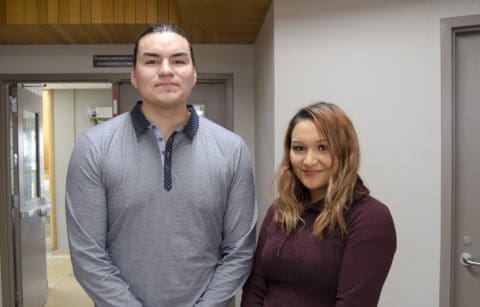Following their elections for a full executive team in mid-October, the Indigenous Students’ Council plans to encourage greater representation of Indigenous students in student groups across campus.
According to the U of S Aboriginal students webpage, the ISC exists to bring together Aboriginal students and involve them in the campus community through cultural, academic and social activities. The ISC represents all Indigenous undergraduate students on campus and, speaking for Métis, First Nations and Inuit students together, provides a unified Aboriginal student voice at the university. Partnerships with local organizations and businesses help facilitate this mission.

Dallas Fiddler, ISC president, and Misty Dreaver, first-year representative, provide a voice for Indigenous students at the U of S.
The ISC is based out of the Gordon Oakes-Red Bear Student Centre, which was designed to be an inclusive, intercultural gathering space, encouraging the values of collaboration, co-operation, humility, reciprocity and sharing, for the entire campus community, but specifically for Indigenous students.
Dallas Fiddler, ISC president and second-year political studies student, explains that in order to provide student advocacy, a major goal of the ISC this year is to encourage more diverse representation of Indigenous students in groups across campus.
“Our plans are to make the ISC an even greater support group for students. We are also reaching out to other councils to create positions for an Indigenous student in their student groups,” Fiddler said, in an email to the Sheaf.
Describing the ISC, Fiddler says that the council includes over 20 students, from both on and off campus, who represent many of the colleges at the U of S. The executive group includes representatives from health science, engineering, arts and science, law, commerce, the Indian Teacher Education Program and St. Thomas More College. In addition, there is a designated first-year representative and four vice-presidents.
At the U of S, over 2,400 current students are self-declared as First Nations, Métis and Inuit. This comprises approximately 11 per cent of the total student population, and Fiddler expects that this number will only grow in the future, increasing the need for representation of Aboriginal students at the university.
“With projections showing that by 2025, 50 per cent of students entering kindergarten will be First Nation, Métis or Inuit, we have an obligation to try and move the conversation forward and help with the transition,” Fiddler said.
He reports that two student associations have already reached out to the ISC looking to increase Indigenous representation within their groups.
“The Political Studies Students’ Association and the Arts and Science Students Union are two councils that approached the ISC and created positions for an Indigenous student,” Fiddler said.
Misty Dreaver, prospective nursing student and first-year representative for the ISC, explains that the council also tries to provide a sense of belonging for Indigenous students on campus. As the first-year representative, Dreaver listens to the concerns of first-year students and provides a voice for them on the council.
“First-year students can email me or come to me personally with any appropriate concerns they may have. I will then take those concerns to the council and we will work on implementing any policies or programs that may help students,” Dreaver said, in an email to the Sheaf.
Fiddler and Dreaver agree that, this year, the ISC w
+ill also strive to strengthen the connections between Indigenous students and the university administration and assist with the Indigenization of the campus.
Dreaver looks forward to the year, sharing the major goals she hopes to achieve as an advocate for new students at the university.
“I would like to bring the first-year students together in a welcoming and safe environment in which we can discuss different tactics that would hopefully help our individual success at the university, as well as voice any concerns we may have within the university. By the end of my time in this position, I would hope that I have made a change within the lives of a few first-year students.”
—
Sydney Boulton
Photo: Jeremy Britz / Photo Editor